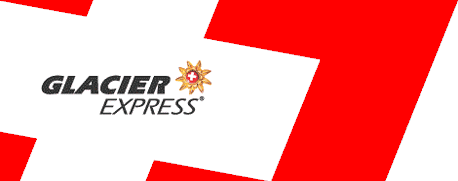The 
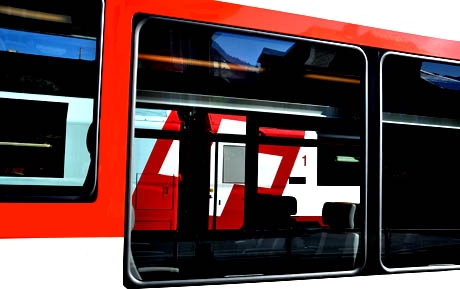  Introduction Introduction
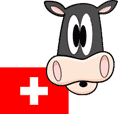 If you have been reading this web site over the past months you will know that I roamed through Switzerland last August. One purpose of that journey was to ride the Glacier Express along part of its route over and through the Swiss Alps. While riding the train offered a unique view of the Alps through the large glass windows of the Panorama coaches it made train photography difficult. One must make the best of any situation so along with this article are the resulting photographs. If you have been reading this web site over the past months you will know that I roamed through Switzerland last August. One purpose of that journey was to ride the Glacier Express along part of its route over and through the Swiss Alps. While riding the train offered a unique view of the Alps through the large glass windows of the Panorama coaches it made train photography difficult. One must make the best of any situation so along with this article are the resulting photographs.
 Glacier Express Overview Glacier Express Overview
The Glacier Express operates over a route between Zermatt in the west of Switzerland and St. Moritz in the east. You may ride the trains in either direction. While the coaches and dining service cars travel the entire route the locomotives pulling the trains change at Disentis (dis-EN-tees). This is because two different railways operate the trains. On the western portion the Matterhorn Gotthard Bahn (MGB) pulls the cars while the eastern half of the route is operated by the Rhätische Bahn (RhB). Trains are generally hauled by rack and adhesion electric locomotives known as model Ge 4/4 III. They were built by SLM, (Schweizerische Lokomotiv und Maschinenfabrik or Swiss Locomotive and Machine Works) at Winterthur, Switzerland, in 1993. These are metre gauge (3 foot and 3.37 inch gauge) locomotives capable of both adhesion and rack operation on the steeper grades along the route. While on the move it's unnoticeable when the train engages a rack section without stopping. The entire journey from one end to the other takes 7 1/2 hours to traverse 291 bridges and 91 tunnels climbing to an elevation of 2,033 metres (6,670 feet) over the Oberalp Pass. The name "Express" is a tongue-in-cheek misnomer for the world's slowest fastest train. 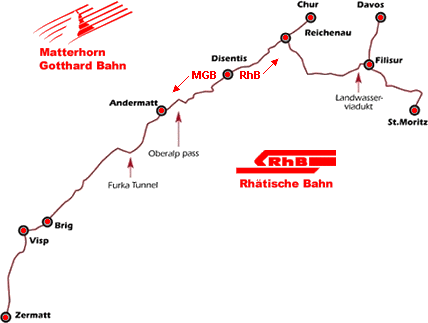
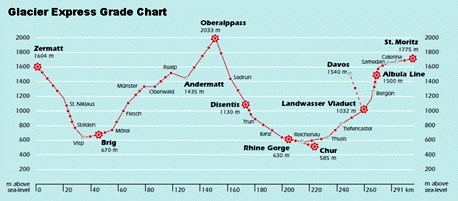
In 2003, the RhB and MGB ordered four new train sets of six passenger cars each for the Glacier Express with the very distinctive red and white Swiss cross livery. Passengers enjoy entertainment at their seat and can receive precise up-to-date announcements and information via headphones on the part of the line they currently travel. To compensate for the large window surface area double redundant air conditioners provide a climate controlled atmosphere through the impressive scenery any time of year. The pneumatic spring fitted Stadler bogies, which are connected to the railcar floor via a rotating assembly ensure a quiet and comfortable ride. Each car's low weight is due to the employment of lightweight construction materials used throughout the entire train.  Matterhorn Gotthard Bahn (MGB) Matterhorn Gotthard Bahn (MGB)
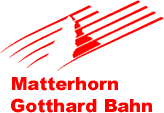 The Matterhorn Gotthard Bahn (MGB) was created in 2003 through an amalgamation of the Furka Oberalp Bahn (FO) and BVZ Zermatt Bahn (BVZ). The railway's name comes from the Matterhorn and St. Gotthard Passes. The Matterhorn Gotthard Bahn (MGB) was created in 2003 through an amalgamation of the Furka Oberalp Bahn (FO) and BVZ Zermatt Bahn (BVZ). The railway's name comes from the Matterhorn and St. Gotthard Passes.
The MGB network is 144 kilometres (89.5 miles) long and stretches from Zermatt through Visp, Brig, Oberwald, the Furka Base Tunnel beneath Furka pass, Realp, Andermatt, and finally Disentis. From Andermatt, a branch line (the formerly independent Schöllenenbahn) extends to Göschenen, at the Northern end of the Gotthard rail tunnel. Between Oberwald and Realp the line used to climb over the Furka pass at an elevation of 2,162 metres (7,093 feet) above sea level but wasn't operable during winter. Today, the 15.34-kilometre-long (9.53 miles) Furka Base Tunnel, drills through the mountains at an elevation of just 1,564 metres (5,131 feet) above sea level. The old line is an attractive scenic route operated by the Dampfbahn Furka Bergstrecke (DFB) using heritage steam engines in the summer months. There is a connection to the Rhätische Bahn in Disentis where the Glacier Express continues eastward to Chur and St. Moritz being headed by RhB locomotives.  Rhätische Bahn (RhB) Rhätische Bahn (RhB)
 The Rhätische Bahn (RhB) has the largest network of all the private railways in Switzerland. The company operates these railways in the southeastern most canton of Graubünden. The Swiss Federal Railways SBB, CFF, and FFS, extend only a few kilometres over the cantonal border into the capital at Chur. The Rhätische Bahn (RhB) has the largest network of all the private railways in Switzerland. The company operates these railways in the southeastern most canton of Graubünden. The Swiss Federal Railways SBB, CFF, and FFS, extend only a few kilometres over the cantonal border into the capital at Chur.
From Disentis, elevation 1,142 metres (3,750 feet), the line descends towards the Rhine Gorge of Ruinaulta before reaching Chur and the connection to St. Moritz. Long sections of this line use a rack system both for ascending steep grades and to control the descent downgrade. RhB serves the major tourist centres of St. Moritz and Davos, and one of the lines, the Bernina line, crosses the Bernina Pass to the Italian border then on to Tirano, where there is a link to Italian railways. In 2008 the Albula and Bernina lines were added to the list of UNESCO World Heritage Sites.  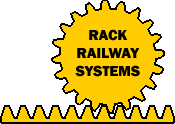 Rack Systems Rack Systems
Riggenbach, Strub, and Abt are typical rack systems in use today on the world's railways. A rack railway, or cog railway, contains a toothed rack between the running rails. Trains are fitted with one or more cog wheels that mesh with this rack. This allows trains to operate on very steep grades.
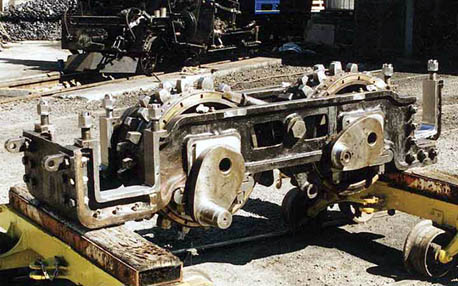
Example of a steam locomotive Abt cog wheel drive assembly.
 SLM (Schweizerische Lokomotiv und Maschinenfabrik) SLM (Schweizerische Lokomotiv und Maschinenfabrik)
The Swiss built their first rack locomotive in 1858. From that point on they continued to pioneer technical developments leading to today's modern adhesion and rack locomotives. The Schweizerische Lokomotiv und Maschinenfabrik (SLM) was founded in 1871. They manufactured mainline, shunting, and rack locomotives (on which they were specialists), all in steam, electric, gasoline, or diesel propulsion. Railway coaches, diesel engines, marine engines, gearboxes, compressors, vacuum pumps, blowers, and gas boosters. The number of workers at this firm rose form 450 in 1880, to 1,300 in 1900, and 1,900 by 1920. Since its foundation in 1871 SLM has built well over 5,600 locomotives and powered railcars for operators world wide. Jakob Buchli worked for SLM in Winterthur as head of their design office until 1910 when he switched to another company. Returning in 1924 he was SLM's technical director of locomotive construction until 1930. One of his most important designs was the Buchli drive, named after him, the Java bogie, Winterthur universal drive, and the duplex bogie for passenger carriages.
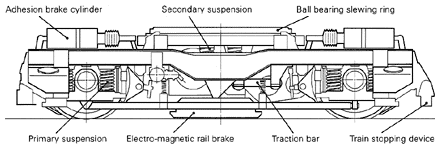
Example of a modern adhesion and rack railway bogie used on the St. Gallen Gais Appenzell, Martigny Châtelard, and the Indonesian State Railways. Click to see the enlarged drawing of the side and top view.
In 1961 Sulzer acquired SLM, Winterthur. This was the beginning of a boom in the large diesel-engine business.
In 1992 SLM turned back to producing steam locomotives, designed around advanced steam technology, but only until 2000 when they sold that portion of the company to Dampflokomotiv und Maschinenfabrik (DLM AG).  Stadler Stadler
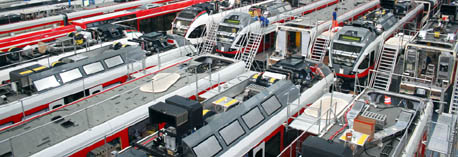
Production line at a Stadler Rail Group plant.
In 2005 Stadler Rail took over the operations of SLM. Stadler Rail, based in Bussnang, Switzerland, is a Swiss manufacturer of passenger rolling stock. Stadler Rail Group with eight sites in Bussnang, Altenrhein, Winterthur (Switzerland), Berlin (Germany), Siedlce (Poland), Pusztaszabolcs, Szolnok (Hungary), and Algiers (Algeria), focuses on the regional and suburban market, light regional express railway service, and streetcars. Stadler Rail's intention is to remain number one in the rack railway vehicle market. It has positioned itself as a supplier complementing global rail vehicle builders such as Alstom, Bombardier, and Siemens.
In the past few years Stadler has closed the last existing production gaps by selectively expanding into the areas of electrical engineering and bogie (truck) construction.
 News Stories News Stories
1 Jul 1993 - The New Glacier Express
30 Oct 2003 - Stadler Altenrhein AG is Building Panorama...
5 Apr 2005 - The Glacier Express - Continuous Operational and...
14 Oct 2009 - The First New RhB Multiple Unit Train Rolls Out of...
6 Nov 2009 - Glacier Express and Ticino 29 Dec 2009 - 2 Jan 2010
6 Nov 2009 - Stadler Pursues International Ambitions  Bibliography Bibliography

| Glacier Express St. Moritz - Zermatt
Hans E. Rübesamen and Iris Furrier - 2006
119 pages - ? photos - ? drawings - ? maps - Hardcover
6 5/8 x 8 7/8 inches - 16.8 x 22.4 centimetres
GeoCenter - German text
| 
| Glacier Express: From the Engadine to the Matterhorn
Klaus Fader - 2005
139 pages - ? photos - ? drawings - ? maps - Hardcover
10 7/8 x 8 5/8 inches - 27.8 x 22 centimetres
Franckh-Kosmos Verlag - German text
| 
| Glacier Express: Around the Slowest Express Train in the World
Ronald Gohl and Hans-Bernhard Schönborn - 2008
135 pages - ? photos - ? drawings - ? maps - Hardcover
8 1/2 x 11 1.4 inches - 21.4 x 28.4 centimetres
GeraMond - German text
| 
| Glacier Express from St. Moritz to Zermatt
Klaus Eckert - 2008
128 pages - ? photos - ? drawings - ? maps - Paperback
4 1/4 x 7 3/8 inches - 11 x 18.8 centimetres
Travel House Media - German text
| 
| Glacier Express, Bernina Express and the Rhaetian Railway
Achim Walder and Ingrid Walder - 2008
200 pages - ? photos - ? drawings - ? maps - Paperback
4 1/4 x 8 1/4 inches - 10.8 x 21 centimetres
German text
| 
| The Big Book of Alpine Railways: Over 150 Years of Conquest of the Alps
Mark Hehl - 2005
144 pages - ? photos - ? drawings - ? maps - Hardcover
9 3/4 x 12 inches - 24.6 x 30.4 centimetres
GeraMond - German text
| 
| 125 Jahre Schweizerische Lokomotiv und Maschinenfabrik 1871-1996
Kaspar Vogel - ?
144 pages - 140 photos - ? drawings - ? maps - Hardcover
? x ? inches - ? x ? centimetres
Publisher unknown - German text
|
 Associated Web Sites Associated Web Sites
Glacier Express
Matterhorn Gotthard Bahn (MGB)
Rhätische Bahn (RhB)
Stadler Rail Group
The Buchli Drive
Dampflokomotiv und Maschinenfabrik (DLM)
The Ultimate Steam Page
Dampfbahn Furka Bergstrecke
Rail Info Switzerland
The European Railway Server
RhB for MSTS
HOe Glacier Express Rolling Stock 
| 
